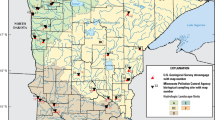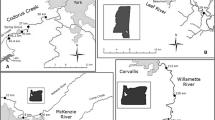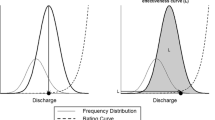Abstract
Determination of ecological responses to river flows is fundamental to understanding how flow-dependent ecosystems have been altered by regulation, water diversions and climate change, and how to effect river restoration. Knowledge of ecohydrological relationships can support water management and policy, but this is not always the case. Management rules have tended to be developed ahead of scientific knowledge. The lag between practice and knowledge could be addressed by using historical monitoring data on ecological responses to changes in flows to determine significant empirical ecohydrological relationships, as an adjunct to investigating responses prospectively. This possibility was explored in the Murray–Darling Basin, Australia. We assessed 359 data sets collected during monitoring programs across the basin. Of these, only 32 (9%) were considered useful, based on a match between the scale at which sampling was done and ecological responses are likely to occur, and used to test flow–ecology predictions for phytoplankton, macroinvertebrates, fishes, waterbirds, floodplain trees, basin-scale vegetation and estuarine biota. We found relationships between flow and ecological responses were likely to be more strongly supported for large, long-lived, widespread biota (waterbirds, basin-scale vegetation, native fishes), than for more narrowly distributed (e.g. estuarine fishes) or smaller, short-lived organisms (e.g. phytoplankton, macroinvertebrates). This pattern is attributed to a mismatch between the design of monitoring programs and the response time frames of individual biota and processes, and to the use of local river discharge as a primary predictor variable when, for many biotic groups, other predictors need to be considered.






Similar content being viewed by others
References
Allan JD, Erikson DL, Fay J (1997) The influence of catchment land use on stream integrity across multiple spatial scales. Freshw Biol 37:149–161
Anderson MJ (2004) DISTLM v.5: a FORTRAN computer program to calculate a distance-based multivariate analysis for a linear model. Department of Statistics, University of Auckland, Auckland
Arthington AH (2012) Environmental flows: saving rivers in the Third Millennium. University of California Press, Berkeley
Arthington AH, Bunn SE, Poff NL, Naiman RJ (2006) The challenge of providing environmental flow rules to sustain river ecosystems. Ecol Appl 16:1311–1318
Arthington AH et al (2012) Ecological limits of hydrologic alteration: a test of the ELOHA framework in south-east Queensland. National Water Commission, Canberra
Arthur AD, Reid JRW, Kingsford RT, McGinness HM, Ward KA, Harper MJ (2012) Breeding flow thresholds of colonial breeding waterbirds in the Murray–Darling Basin, Australia. Wetlands 32:257–265
Baldwin DS et al (2013) Provisioning of bioavailable carbon between wet and dry periods in a semi-arid floodplain. Oecologia 172:539–550
Box GEP, Jenkins GM (1976) Time series analysis: forecasting and control. Prentice Hall, New York
Brooks AJ, Chessman BC, Haeusler T (2011) Macroinvertebrate traits distinguish unregulated rivers subject to water abstraction. J N Am Benthol Soc 30:419–435
Bureau of Meteorology (2004) Annual Australian Climate Statement 2003. http://www.bom.gov.au/announcements/media_releases/climate/change/2004010.shtml. Accessed 23 Sept 2016
Bureau of Meteorology (2007) Annual Australian Climate Statement 2006. http://www.bom.gov.au/announcements/media_releases/climate/change/20070103.shtml. Accessed 23 Sept 2016
Chessman BC, Royal MJ (2004) Bioassessment without reference sites: use of environmental filters to predict natural assemblages of river macroinvertebrates. J N Am Benthol Soc 23:599–615
Chiew FHS, Teng J, Kirono D, Frost AJ, Bathois JM, Vaze J, Viney NR, Young WJ, Hennessy KJ, Cai WJ (2008) Climate data for hydrologic scenario modelling across the Murray–Darling Basin. A report to the Australian Government from the CSIRO Murray-Darling Basin Sustainable Yields Project. CSIRO, Canberra
Clarke KR, Gorley RN (2006) PRIMER v6: user manual/tutorial. PRIMER-E, Plymouth
Colloff MJ (2014) Flooded forest and desert creek: ecology and history of the river red gum. CSIRO Publishing, Melbourne
Colloff MJ, Baldwin DS (2010) Resilience of floodplain ecosystems in a semi-arid environment. Rangeland J 32:305–314
Colloff MJ, Overton IC, Cuddy SM, Doody TM, Henderson B, Capon SJ (2010) Improving environmental water planning and policy outcomes: ecological responses to flow regimes in the Murray–Darling Basin. National Water Commission, Canberra
Colloff MJ, Caley P, Saintilan N, Pollino CA, Crossman NC (2015) Long-term ecological trends of flow-dependent ecosystems in a major river basin. Mar Freshw Res 66:957–969
Croome R et al (2011) River Murray water quality monitoring program: phytoplankton data trend analysis 1980–2008. Murray-Darling Freshwater Research Centre, Wodonga
CSIRO (2008) Water availability in the Murray. A report to the Australian Government from the CSIRO Murray-Darling Basin Sustainable Yields Project. CSIRO, Canberra
Cullen P (1990) the turbulent boundary between water science and water management. Freshw Biol 24:201–209
Davie AW, Mitrovic SM (2014) Benthic algal biomass and assemblage changes following environmental flow releases and unregulated tributary flows downstream of a major storage. Mar Freshw Res 65:1059–1071
Davies PE, Harris JH, Hillman TJ, Walker KF (2008) Sustainable Rivers Audit report 1. A report on the ecological health of rivers in the Murray–Darling Basin. Murray-Darling Basin Commission, Canberra
Davies PE, Harris JH, Hillman TJ, Walker KF (2010) The Sustainable Rivers Audit: assessing river ecosystem health in the Murray–Darling Basin, Australia. Mar Freshw Res 61:764–777
Doody TM, Benger S, Pritchard J, Overton IC (2014) Ecological response of Eucalyptus camaldulensis (river red gum) to extended drought and flooding along the River Murray, South Australia (1997–2011) and implications for environmental flow management. Mar Freshw Res 65:1082–1093
Downes BJ (2010) Back to the future: little-used tools and principles of scientific inference can help disentangle effects of multiple stressors on freshwater ecosystems. Freshw Biol 55(Suppl. 1):60–79
DSE (2005) Framework for describing the ecological character of Ramsar wetlands: including a description of the ecological character of the Barmah Forest Ramsar site. Department of Sustainability and Environment, Melbourne
Eldridge SR, Thorburn PJ, McEwan KL, Hatton TJ (1993) Health and structure of Eucalyptus communities on Chowilla and Monoman Islands of the River Murray Floodplain, South Australia. CSIRO Division of Water Resources, Adelaide
Ferguson GJ (2012) The South Australian Lakes and Coorong Fishery: fishery stock status report for PIRSA Fisheries and Aquaculture. SARDI Research Report Series No. 675. South Australian Research and Development Institute (Aquatic Sciences), Adelaide
Ferguson GJ, Ward TM, Ye Q, Geddes MC, Gillanders BM (2013) Impacts of drought, flow regime and fishing on the fish assemblages in southern Australia’s largest temperate estuary. Estuar Coast 36:737–753
Fu B, Burger I (2015) Riparian vegetation NDVI dynamics and its relationship with climate, surface water and groundwater. J Arid Environ 113:59–68
Goslee SC, Urban DL (2007) The ecodist package for dissimilarity-based analysis of ecological data. J Stat Softw 22:1–19
Harris GP, Heathwaite L (2012) Why is achieving good ecological outcomes in rivers so difficult? Freshw Biol 57(Suppl. 1):91–107
Holling CS (1992) Cross-scale morphology, geometry and dynamics of ecosystems. Ecol Monogr 62:447–502
Jolly ID, Walker GR, Thorburn PJ, Hollingsworth ID (1992) The cause of black box decline in the Chowilla Anabranch region, South Australian, and possible ameliorative approaches. In: Catchments of green: proceedings of the national conference on vegetation and water management, Adelaide. Greening Australia, Canberra, pp 33–41
King AJ, Ward KA, O’Connor P, Green D, Tonkin Z, Mahoney J (2010) Adaptive management of an environmental watering event to enhance native fish spawning and recruitment. Freshw Biol 55:17–31
Kingsford RT, Auld KM (2005) Waterbird breeding and environmental flow management in the Macquarie Marshes, arid Australia. River Res Appl 21:187–200
Kingsford RT, Mac Nally R, King A, Walker KF, Bino G, Thompson R, Wassens S, Humphries P (2015) A commentary on ‘Long-term ecological trends of flow-dependent ecosystems in a major regulated river basin’, by Matthew J. Colloff, Peter Caley, Neil Saintilan, Carmel A. Pollino and Neville D. Crossman. Mar Freshw Res 66:970–980
Kirby M, Connor J, Bark R, Qureshi E, Keyworth S (2012) The economic impact of water reductions during the Millennium Drought in the Murray–Darling Basin. In: Proceedings, 56th Australian agricultural and resource economics conference, 7–10 February 2012, Fremantle. http://ageconsearch.umn.edu/handle/124309. Accessed 26 June 2016
Koehn JD, King AJ, Beesley L, Copeland C, Zampatti B, Mallen-Cooper M (2014) Flows for native fish in the Murray–Darling Basin: lessons and considerations for future management. Ecol Manag Restor 15:40–50
Leblanc M, Tweed S, Van Dijk A, Timbal B (2012) A review of historic and future hydrological changes in the Murray–Darling Basin. Glob Planet Change 80–81:226–246
Leslie DJ (2001) Effect of river management on colonially-nesting waterbirds in the Barmah-Millewa forest, south-eastern Australia. Reg Rivers Res Manag 17:21–36
Levin S (1992) The problem of pattern and scale in ecology. Ecology 73:1943–1967
Lindenmayer DB, Likens GE (2010) The science and application of ecological monitoring. Biol Conserv 143:1317–1328
Lovett GM et al (2007) Who needs environmental monitoring? Front Ecol Environ 5:253–260
Lytle DA, Poff NL (2004) Adaptation to natural flow regimes. Trends Ecol Evol 19:94–100
McLoughlin CA, Deacon A, Sithole H, Gyedu-Ababio T (2011) History, rationale, and lessons learned: thresholds of potential concern in Kruger National Park river adaptive management. Koedoe 53(2):69–95. https://doi.org/10.4102/koedoe.v53i2.996
McMahon TA, Finlayson BL (2003) Droughts and anti-droughts: the low flow hydrology of Australian rivers. Freshw Biol 48:1147–1160
MDBA (2014) Basin-wide environmental watering strategy. Murray-Darling Basin Authority, Canberra
MDBC (2005) Survey of river red gum and black box health along the River Murray in New South Wales, Victoria and South Australia—2004. Murray-Darling Basin Commission, Canberra
MDBC (2006a) The River Murray Channel Icon Site environmental management plan 2006–2007. Murray-Darling Basin Commission, Canberra
MDBC (2006b) The Gunbower-Perricoota Forest Icon Site environmental management plan 2006–07. Murray-Darling Basin Commission, Canberra
MDBC (2006c) The Barmah-Millewa Forest Icon Site environmental management plan 2006–07. Murray-Darling Basin Commission, Canberra
MDBC (2006d) The Lower Lakes, Coorong and Murray Mouth Icon Site environmental management plan 2006–2007. Murray-Darling Basin Commission, Canberra
MDFRC (2005) Barmah Wetland System environmental monitoring program parts A & B. Murray-Darling Freshwater Research Centre, Wodonga
Merrin L, Caitcheon G, Dovers E, Jin W, Henderson B (2009) Hydrological data. In: Overton IC, Colloff MJ, Doody TM, Henderson B, Cuddy SM (eds) Ecological outcomes of flow regimes in the Murray–Darling Basin. CSIRO Water for a Healthy Country National Research Flagship, Canberra, pp 33–44
Newall P, Lloyd L, Gell P, Walker K (2008) Riverland Ramsar site ecological character description. Lloyd Environmental, Melbourne
Newton GM (1996) Estuarine ichthyoplankton ecology in relation to hydrology and zooplankton dynamics in a salt-wedge estuary. Mar Freshw Res 47:99–111
Overton IC, McKewan K, Gabrovsek C, Sherrah JR (2006) The River Murray Floodplain Inundation Model (RiM-FIM): Hume Dam to Wellington. CSIRO Water for a Healthy Country National Research Flagship, Canberra
Overton IC, Colloff MJ, Doody TM, Henderson B, Cuddy SM (eds) (2009) Ecological outcomes of flow regimes in the Murray–Darling Basin. CSIRO Water for a Healthy Country National Research Flagship, Canberra
Paton DC, Rogers DJ, Hill BM, Bailey CP, Ziembicki M (2009) Temporal changes to spatially stratified waterbird communities of the Coorong, South Australia: implications for the management of heterogeneous wetlands. Anim Conserv 12:408–417
Philips B, Muller K (2006) Ecological character of the Coorong, Lakes Alexandrina and Albert Wetland of international importance. Department for Environment and Heritage, Adelaide
Poff NL, Zimmerman JKH (2010) Ecological responses to altered flow regimes: a literature review to inform the science and management of environmental flows. Freshw Biol 55:194–205
Poff NL et al (2010) The ecological limits of hydrological alteration (ELOHA): a new framework for developing regional environmental flow standards. Freshwater Biol 55:147–170
Potter NJ, Chiew FHS, Frost AJ (2010) An assessment of the severity of recent reductions in rainfall and runoff in the Murray–Darling Basin. J Hydrol 381:52–64
Reid JRW, Colloff MJ, Arthur AD, McGinness HM (2013) Influence of catchment condition and water resource development on waterbird assemblages in the Murray–Darling Basin, Australia. Biol Conserv 165:25–34
Roberts J (2001) Species-level knowledge of riverine and riparian plants: a constraint for determining flow requirements in the future. Aust J Water Res 5:21–31
Roberts J, Marston F (2011) Water regime for wetland and floodplain plants. A source book for the Murray–Darling Basin. National Water Commission, Canberra
Rogers DJ, Paton DC (2009) Changes in the distribution and abundance of Ruppia tuberosa in the Coorong. CSIRO Water for a Healthy Country National Research Flagship, Canberra
Rogers K, Ralph TJ (2011) Floodplain wetland biota in the Murray–Darling Basin: water and habitat requirements. CSIRO Publishing, Melbourne
Rogers K, Saintilan N, Colloff MJ, Wen L (2013) Application of thresholds of potential concern and limits of acceptable change in the condition assessment of a significant wetland. Environ Monit Assess 185:8583–8600
Rosenfeld JS (2017) Developing flow–ecology relationships: implications of nonlinear biological responses for water management. Freshwater Biol 62:1305–1324
Roth NE, Allan JD, Erikson DE (1996) Landscape influences on stream biotic integrity assessed at multiple spatial scales. Landsc Ecol 11:141–156
Roux DJ, Foxcroft LC (2011) The development and application of strategic adaptive management (SAM) within South African National Parks. Koedoe 53(2):01–05
Schneider DC (1994) Quantitative ecology: spatial and temporal scaling. Academic Press, San Diego
Sims NC, Colloff MJ (2012) Remote sensing of vegetation responses to flooding of a semi-arid floodplain: implications for monitoring ecological effects of environmental flows. Ecol Indic 18:387–391
Sims NC, Chariton A, Jin H, Colloff MJ (2012) A classification of floodplain ecosystems in the Murray–Darling Basin based on changes in flows following water resource development. Wetlands 32:239–248
SKM, Roberts J (2003) Assessment of water management options for Lindsay and Wallpolla Islands. Sinclair Knight Mertz, Melbourne
Stevens SS (1946) On the theory of scales of measurement. Science 103:677–680
Stokes KE, Ward KA, Colloff MJ (2010) Alterations in flood frequency increase exotic and native species richness of understorey vegetation in a temperate floodplain eucalypt forest. Plant Ecol 211:219–233
Syme GJ (2013) Acceptable risk and social values: struggling with uncertainty in Australian water allocation. Stoch Environ Res Risk Assess 28:113–121
Thomas A, O’Hara B, Ligges U, Sturtz S (2006) Making BUGS Open. R News 6:12–17
Van Dijk AIJM et al (2013) The Millennium Drought in southeast Australia (2001–2009): natural and human causes and implications for water resources, ecosystems, economy and society. Water Resour Res 49:1040–1057
Ward KA, Colloff MJ (2010) Ecosystem response modelling for the Barmah-Millewa Forest: the interface between science and management. In: Saintilan N, Overton IC (eds) Ecosystem response modelling in the Murray Darling Basin. CSIRO Publishing, Melbourne, pp 345–356
Webb JA, Stewardson MJ, Koster WM (2010) Detecting ecological responses to flow variation using Bayesian hierarchical models. Freshw Biol 55:108–126
Wen L, Yang X, Saintilan N (2012) Local climate determines the NDVI-based primary productivity and flooding creates heterogeneity in semi-arid floodplain ecosystem. Ecol Model 242:116–126
Zampatti BP, Leigh SJ (2013a) Within-channel flows promote spawning and recruitment of golden perch, Macquaria ambigua ambigua—implications for environmental flow management in the River Murray, Australia. Mar Freshw Res 64:618–630
Zampatti BP, Leigh SJ (2013b) Effects of flooding on recruitment and abundance of Golden Perch, (Macquaria ambigua ambigua) in the lower River Murray. Ecol Manag Restor 14:135–143
Acknowledgements
This research was funded by the National Water Commission and CSIRO Water for a Healthy Country National Research Flagship. We thank Richard Davis and Anthea Brecknell (National Water Commission) for advice and encouragement during the project and Darryl Nielsen (Murray-Darling Freshwater Research Centre) and an anonymous reviewer for their practical and constructive reviews of the manuscript.
Author information
Authors and Affiliations
Corresponding author
Additional information
Handling Editor: Piet Spaak.
Electronic supplementary material
Below is the link to the electronic supplementary material.
Rights and permissions
About this article
Cite this article
Colloff, M.J., Overton, I.C., Henderson, B.L. et al. The use of historical environmental monitoring data to test predictions on cross-scale ecological responses to alterations in river flows. Aquat Ecol 52, 133–153 (2018). https://doi.org/10.1007/s10452-018-9650-y
Received:
Accepted:
Published:
Issue Date:
DOI: https://doi.org/10.1007/s10452-018-9650-y




